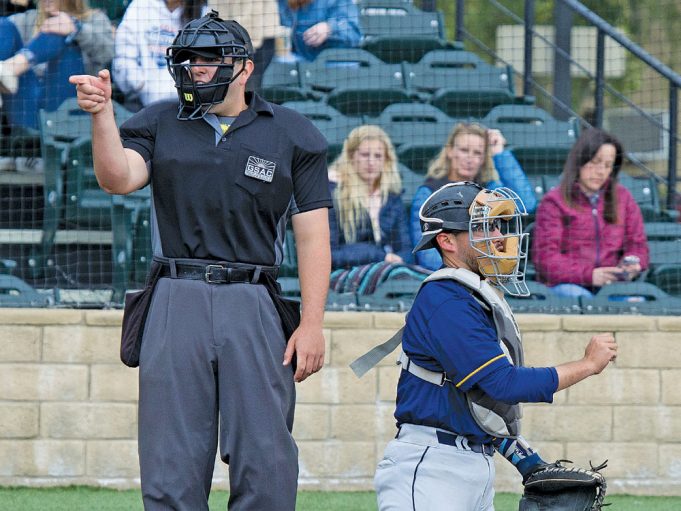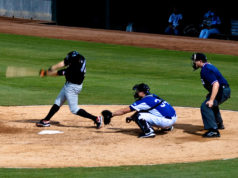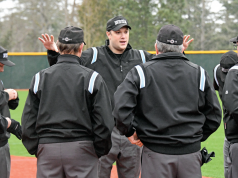U
mpires always stress the importance of good timing behind the plate (and on the bases, but that’s a topic for another day). But to talk about good timing begs the question: What does it mean? And how do we make it happen?
We can be too quick and, for example, ball a pitch that looked like it would be a high fastball because we didn’t give ourselves enough time to see it break down into the strike zone. I once did this on what would have been the game-ending third strike in a high-profile college game; fortunately, the batter — who no doubt knew he wasn’t going to get another gift — swung and missed at the next pitch, which was out of the zone.
Conversely, our timing can be too slow. Then we can second-guess ourselves, with bad results. For example, we see a pitch and instinctively know it caught the corner of the plate — was in our “window” — but because we’re so deliberate we talk ourselves into believing it was out of the zone, so we call it a ball. Analyzing things to the nth degree was required when I was in law school, but it can be counterproductive on the ball field.
In the early ’70s, when I was in the minor leagues, I saw a game with then-NL umpire Paul Runge behind the plate. I thought his timing was awesome and I concentrated on him during the game. A pitch would hit the mitt, there would be about a two-count pause and then he would make his call. He never deviated whether the pitch was down the middle or a foot outside. From then on, I consciously modeled myself after him.
If we’re quicker to call obvious pitches — balls or strikes — than close ones, people may infer we’re unsure of ourselves on the latter ones. Projecting uncertainty is a bad deal. So strive to pause for the same amount of time on each pitch, regardless of where it is. And I think a two-count pause after it hits the mitt is just right — not so quick that you can’t register where a close pitch is, and not so slow that we second-guess ourselves. If we keep the same rhythm on every pitch, we buy time to take a second look at close ones before calling them without anyone being the wiser.
I advocate the same volume whether or not it’s a close call — not so loud that we’re virtually screaming, which isn’t as convincing as some folks think, but not so soft that we’re barely heard, which doesn’t project confidence. Back in the day we poured it on if we had a close “decision” pitch — strike three or ball four — but I think we sell ourselves better if we look like it isn’t our first rodeo and we’re in command. The same forceful-but-not-over-the-top volume on each pitch is part of that sales effort. Keeping the same volume also makes it easier to keep our timing consistent.
Our strike signal can affect our timing. An exuberant signal — like the “punch” or arm jerked skyward that were once in vogue — can make us speed up our call. I favored signaling to the side in a deliberate, crisp, controlled manner. (Too lackadaisical and we won’t convince our mother we know what we’re doing.) This relaxed motion made it easier for me to slow down my timing and keep it the same throughout the game.
Finally, I think our stance can influence our timing. For years I worked on a knee, but I tried to keep my head up and not lean over so that the bulk of my weight was on my front leg. Not only can this distort the strike zone, but over the course of a game putting undue pressure on one leg — usually the left one, as we generally have more right-handed batters — can subconsciously make us want to bail out too quickly when a pitch comes in to take the pressure off that leg.
This is one problem I had with the scissors stance. Even if you keep your weight evenly distributed between the front and back leg it can be easier to get off balance in this stance than it is in, say, a box. I know because I tried it for a while after I got off of my knee when catchers started working more inside. Eventually I went to the box.
I always checked with a partner about the end of the second inning to see if my timing was consistent and not too fast or slow. We can work for ages and not recognize when our tempo is off a bit, and an outsider — at least one who will be honest with us — can tell us if things are amiss. Just as something a bit out of kilter can make a huge difference in our golf swing, it can matter in pitch-calling.
I tried not to deviate from my normal routine, cadence and volume when the game got in later, or extra, innings and heated up. It’s OK for the troops to get excited, but for us to appear to be may send the message we’re in over our heads. And if we get caught up in the hoopla it’s more likely our timing will speed up, which increases the odds of missing a pitch (or more) when things really count.
Finally, I tried not to anticipate what pitch may be thrown. Most of us have a pretty good sense of what to expect in particular situations, but I learned early on that it’s better to take each pitch as it comes without guessing what it will be. Unfortunately, I didn’t always succeed. That’s why, to return to the example I started with, I assessed the accuracy of what I thought would be a fastball, and made my call accordingly, before realizing it was actually a curve that broke right into the heart of the strike zone. Do this enough times and any notion of a solid plate game will go flying out the window.
What's Your Call? Leave a Comment:
Note: This article is archival in nature. Rules, interpretations, mechanics, philosophies and other information may or may not be correct for the current year.
This article is the copyright of ©Referee Enterprises, Inc., and may not be republished in whole or in part online, in print or in any capacity without expressed written permission from Referee. The article is made available for educational use by individuals.


















